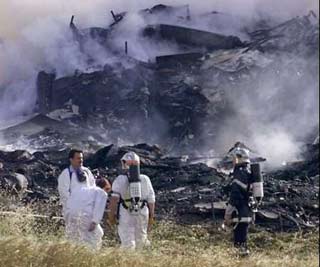France - Japan and super Concord dream
After the crash of the Concord aircraft in Paris in 2000, the French together with the Japanese carried out a research project to build a " super Concord " aircraft with speeds of up to Mach 5 (equivalent to 1,701.45m / seconds), can carry about 300 guests.
In October 2003, three years after the catastrophic aviation accident in Paris, Concord aircraft officially " retired ". However, the French still turned to the reality of this dream of developing this " super-expensive, super-expensive " civil aviation vehicle to popularize and invite Japanese people to join in: Summer 2005, Group of goods French aerospace (GIFAS) and Japanese SJAC signed an agreement
 The old Concord aircraft stopped flying after a catastrophic accident (Photo: aeronautics) studying a new " super Concord " production with research costs of about US $ 5.4 million in 3 years 2005-2008 and hopefully will ship this type of super-fast passenger transport in 2015.
The old Concord aircraft stopped flying after a catastrophic accident (Photo: aeronautics) studying a new " super Concord " production with research costs of about US $ 5.4 million in 3 years 2005-2008 and hopefully will ship this type of super-fast passenger transport in 2015.
Follow the driveway?
"The amount of US $ 1.8 million per year is only enough for advertising printing" , which is a comment from some of the world's aircraft manufacturers with the French-Japanese project. This is also not unreasonable when Airbus has spent $ 12 billion to research and manufacture giant A380 aircraft. Airline specialist Markus Franke of Booz Allen Hamilton said that the current level of aviation technology does not allow people to build civil aircraft with speeds of Mach 5 and, if so, it will be "uneconomical." " When the supersonic plane becomes a means of transporting civil passengers because when the speed of the aircraft passes the " sound barrier " , the amount of fuel consumed becomes horrible.
The use of Concord in the past to transport passengers had to go into the past for the same reason: only a handful of giants , politicians, movie stars had enough " courage ". to ride on a plane that is twice the speed of this sound because the ticket price is " only " $ 10,000 for the London - New York route and each flight can only accommodate about 100 guests. Besides the fuel problem, supersonic aircraft also require maintenance, staff training, other safety costs . more than any conventional aircraft. As a result, the new Super Concord has a speed of Mach 5, with the current and future oil price situation, it is unlikely that the fare will be cheaper than the Concord.
Economic problem
Faced with fuel price pressures and costly costs, especially for security costs, major airlines in the world appear to be no longer " salty " to production projects. giant aircraft, super-fast: Boeing has a project to produce high-speed large transport aircraft called Sonic Cruiser. However, by November 2002, this project was stopped because Boeing bosses had no potential market and the economic efficiency was not high. Airbus also announced " no projects for supersonic civil aircraft ". The representative of Lufthansa Airlines is M.Lamerti, who expressed his "double" attitude when saying that they are also a little interested in supersonic aircraft in the future but at the same time said in a very practical way that "It is very unworthy to spend a lot of money just to save a few hours ."
The Japanese are still optimistic when they say they have an airplane engine that can reach Mach 5 and the price will be cheap because the number of passengers per flight is three times that of the previous Concorde. Nearly a year ago, Japan tested aerodynamics for the Concord aircraft model for the future. The trial was conducted in Australia and " achieved promising results ".
- Invented the program 'read', seize the dream
- The atonement journey: The word criminal became a super detective in France
- There will be a machine to read
- Dream of death
- The reasons people dream when they go to sleep
- Japan and France drafted a new nuclear safety standard
- What does it mean to find yourself guilty?
- The first super typhoon of 2014: Super typhoon Neoguri flipped on the sea
- Discover the source of the dream
- Equipment allows people to dream as they wish
- A medicine that will help you triple your Lucid dream experience
- Decode the dream of a dog
 Van Allen's belt and evidence that the Apollo 11 mission to the Moon was myth
Van Allen's belt and evidence that the Apollo 11 mission to the Moon was myth The levels of civilization in the universe (Kardashev scale)
The levels of civilization in the universe (Kardashev scale) Today Mars, the sun and the Earth are aligned
Today Mars, the sun and the Earth are aligned The Amazon owner announced a secret plan to build a space base for thousands of people
The Amazon owner announced a secret plan to build a space base for thousands of people